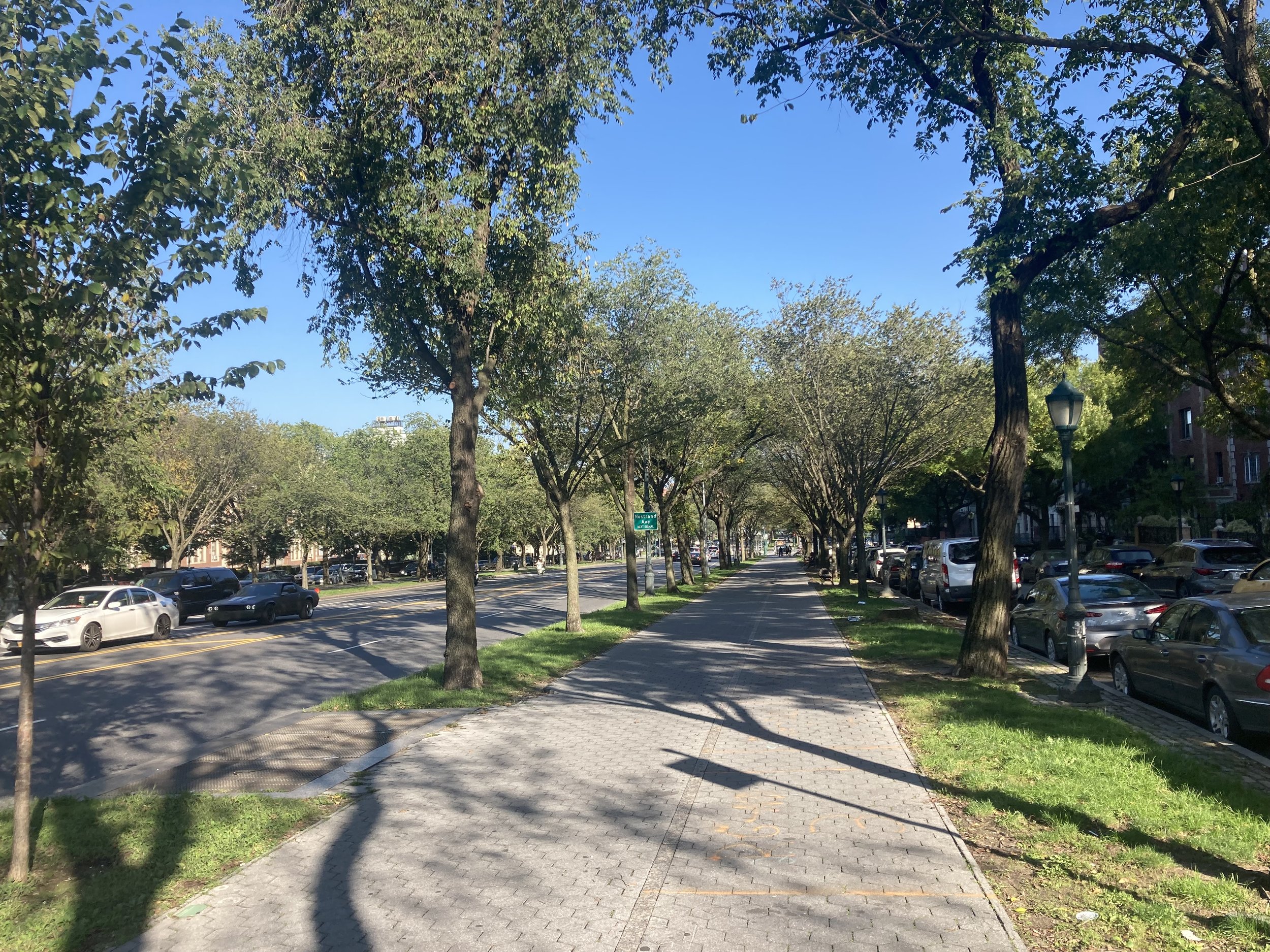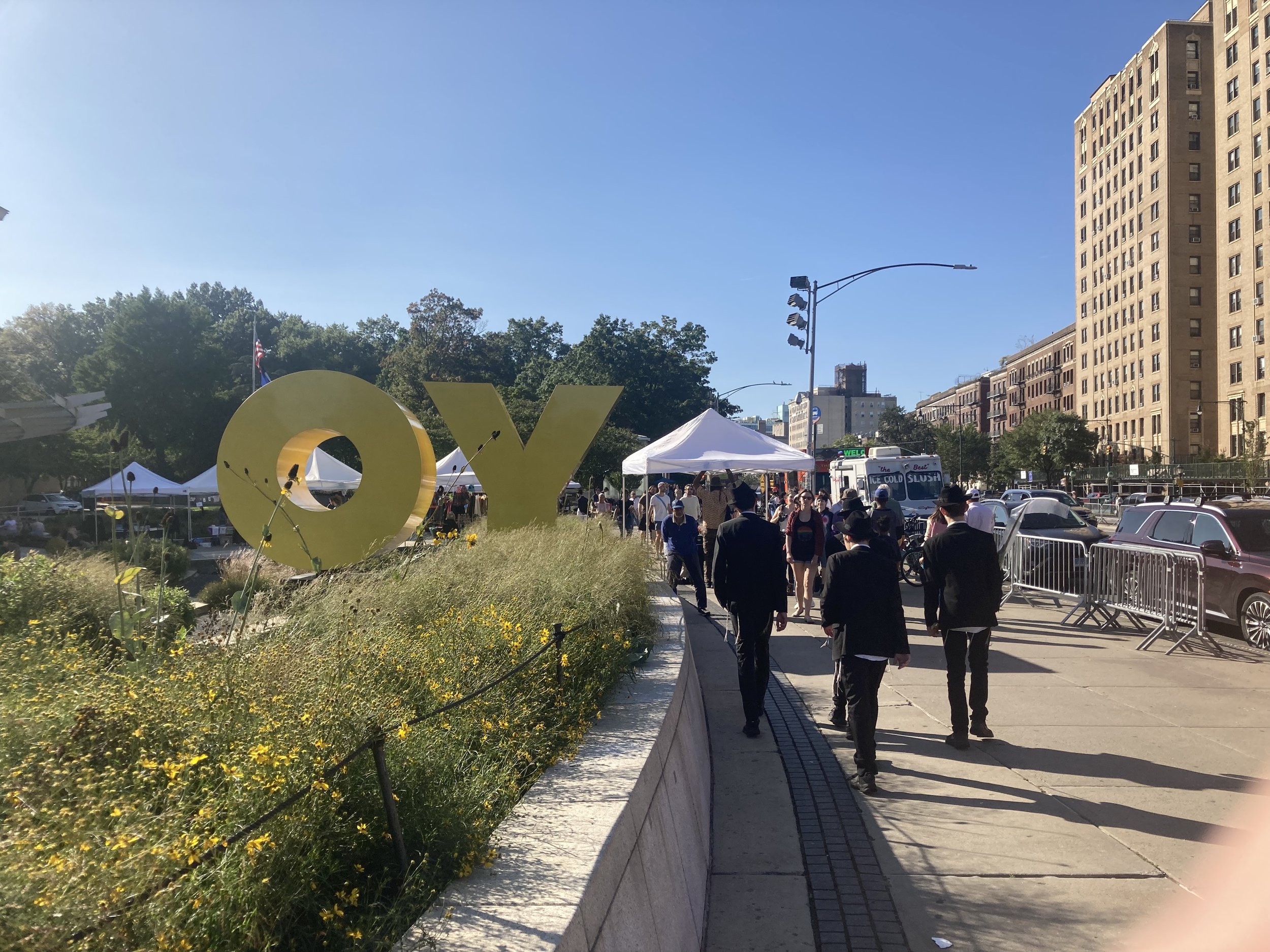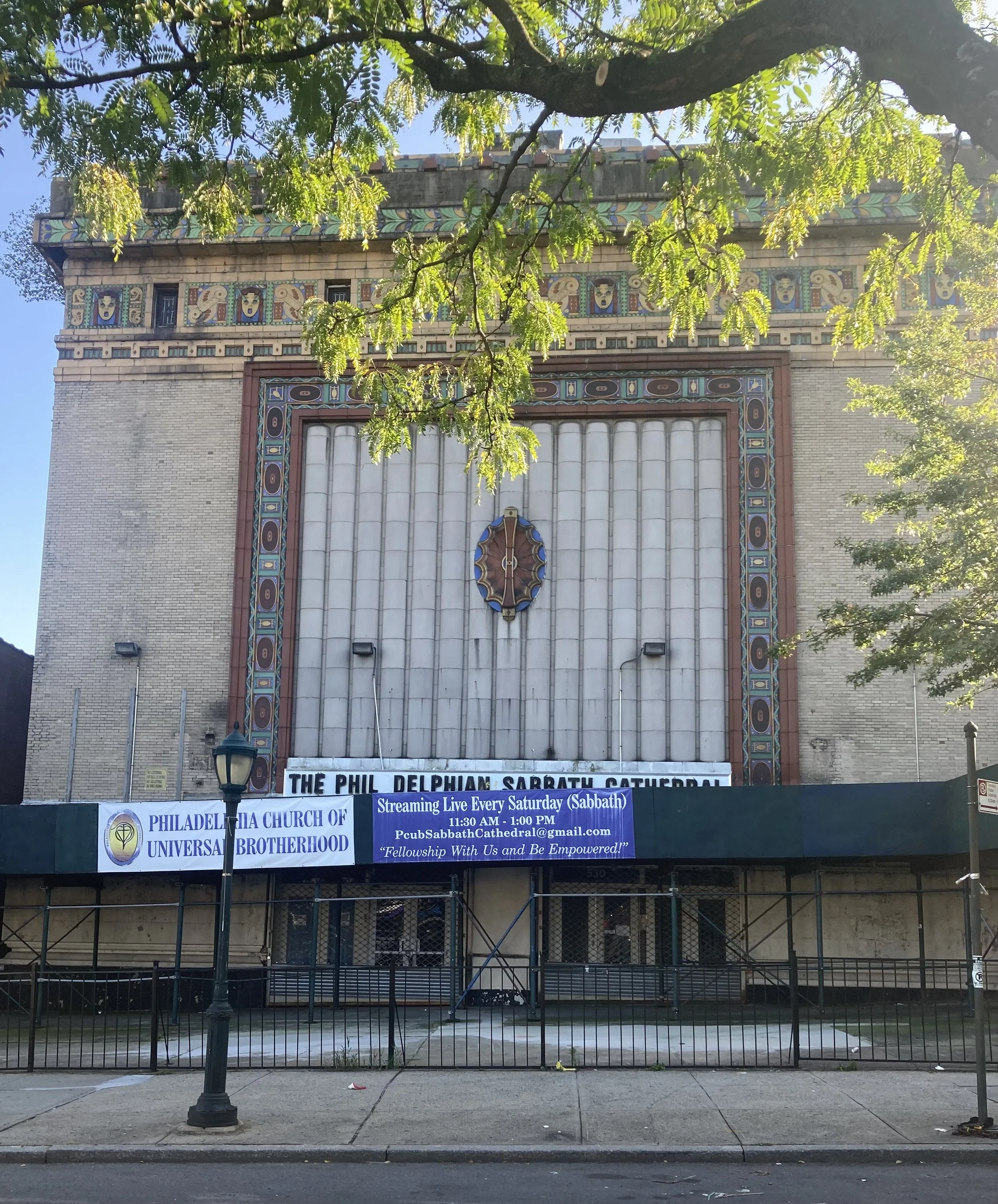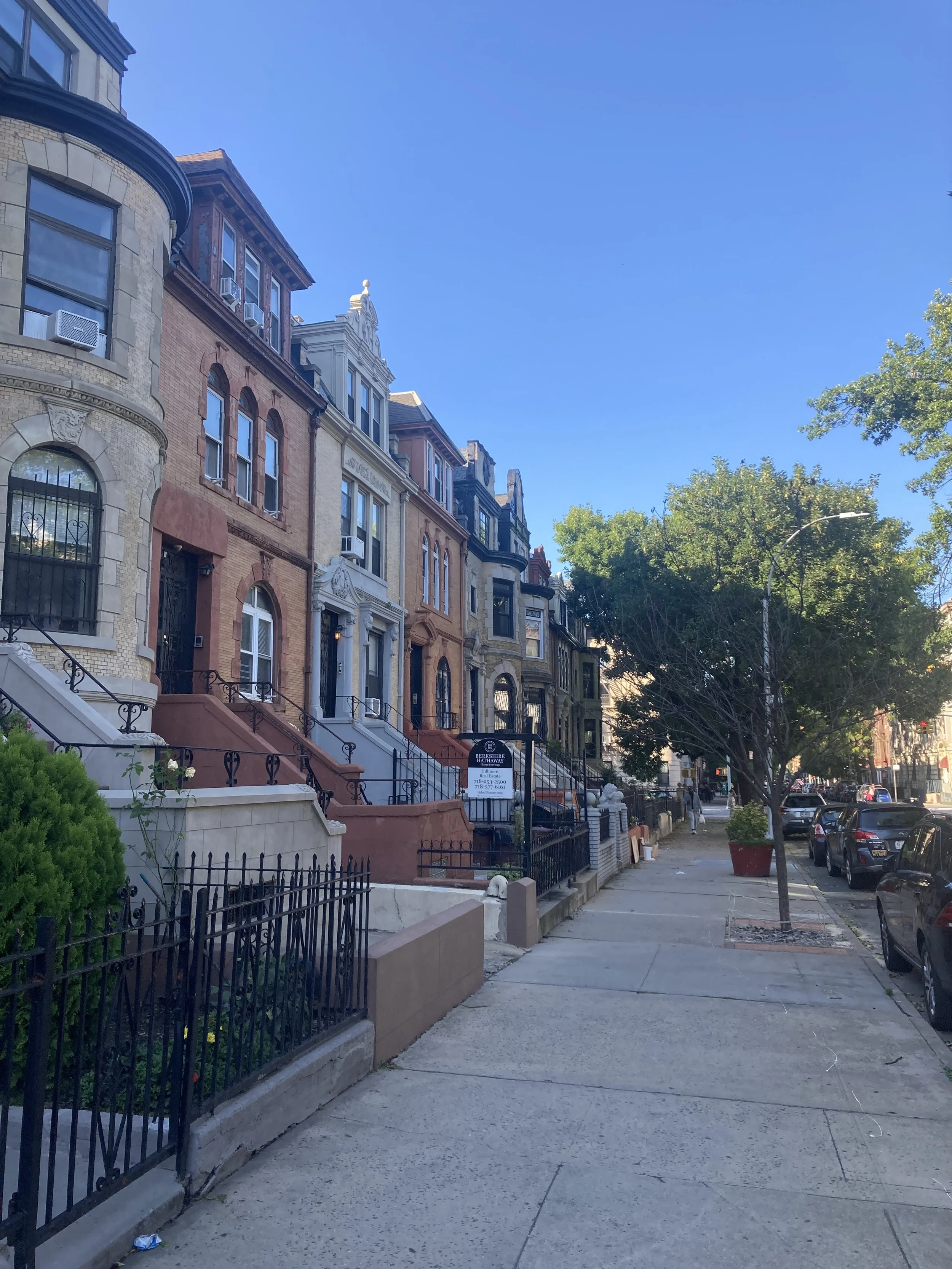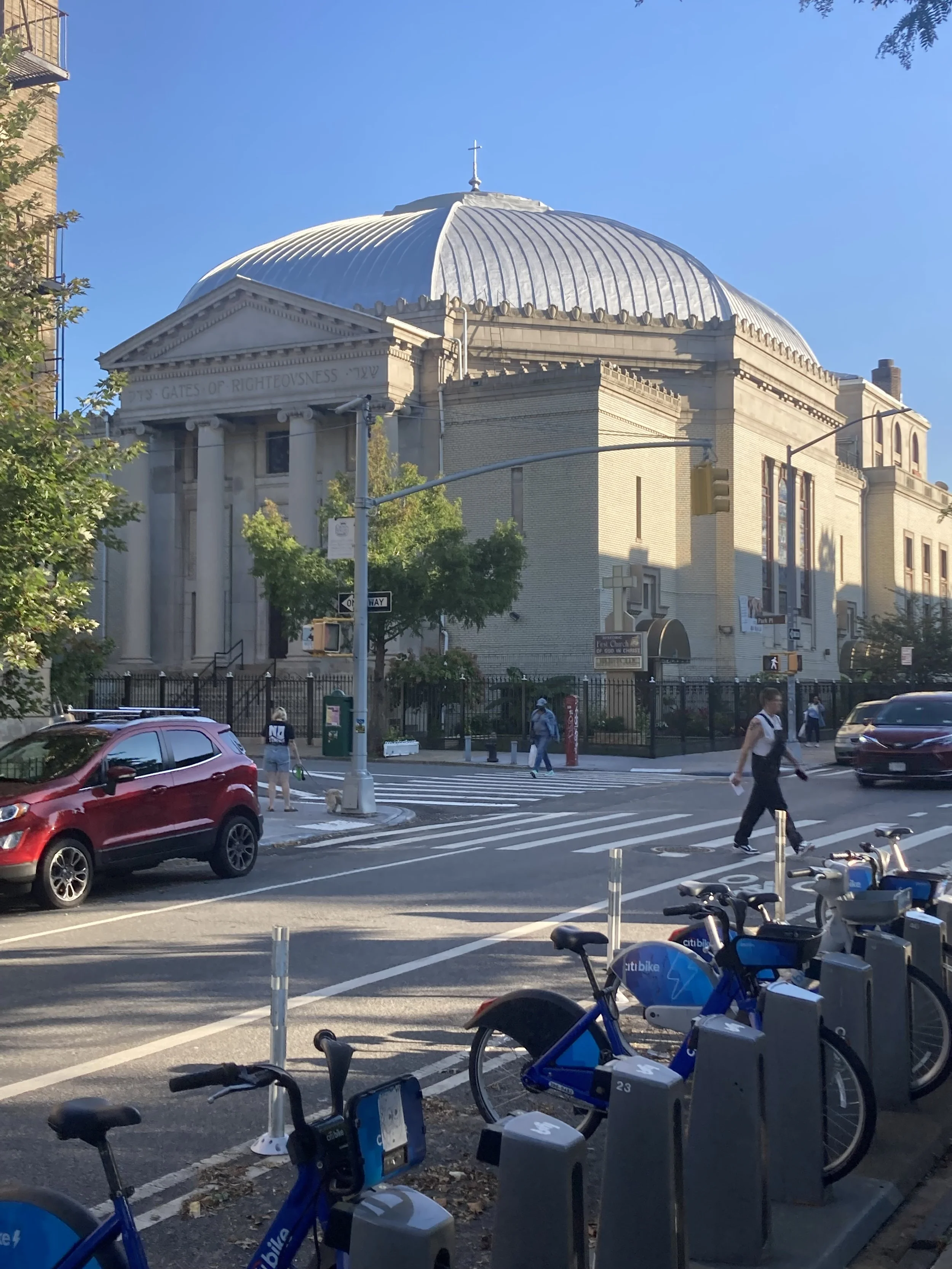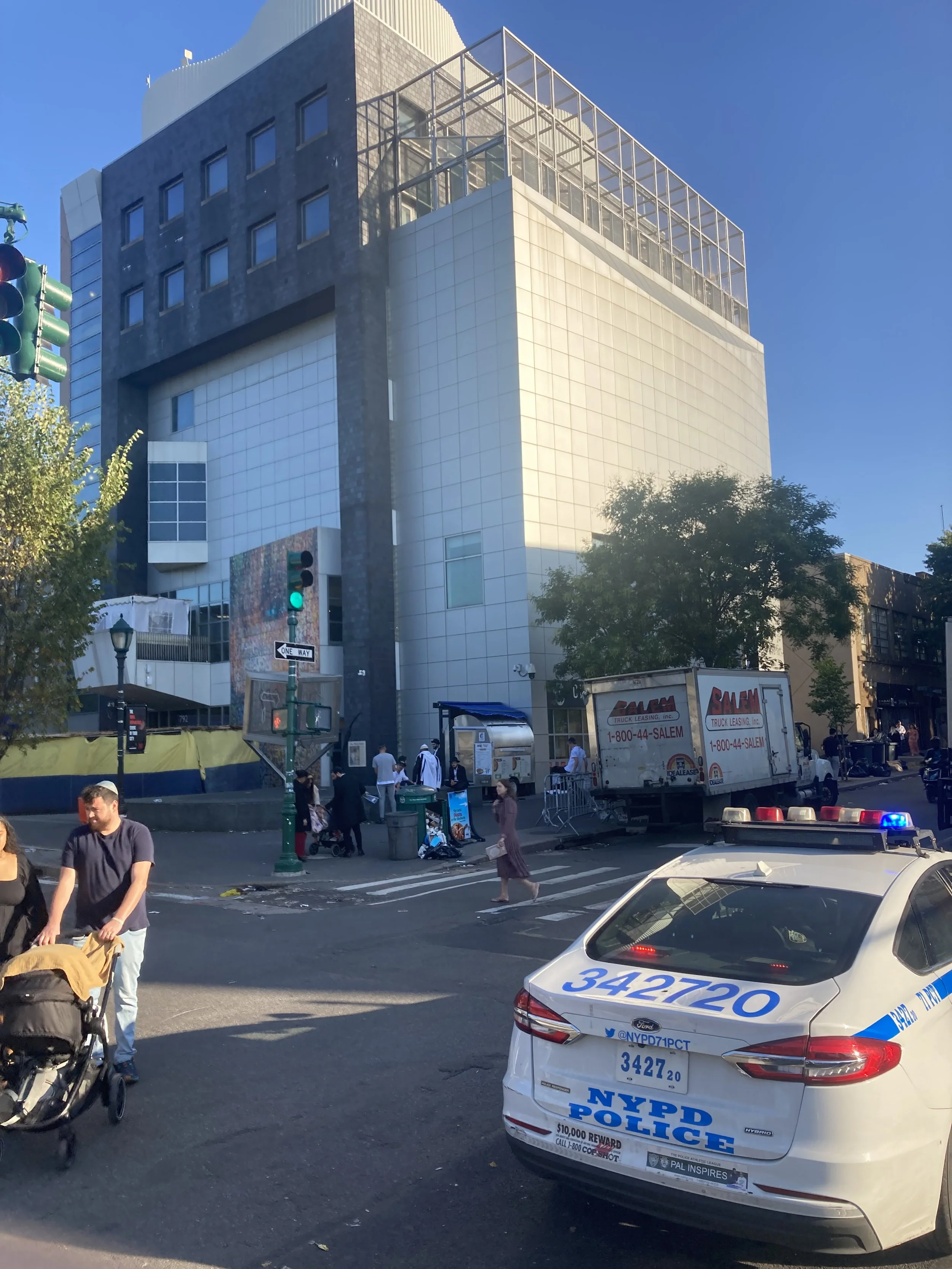Eastern Parkway (Brooklyn)
WHERE: Eastern Parkway and a detour into the northern part of Crown Heights, Brooklyn
START: Eastern Parkway - Brooklyn Museum subway station (2, 3 trains), fully accessible
FINISH: Crown Heights - Utica Avenue subway station (3, 4 trains), fully accessible
DISTANCE: 2.54 miles (4.09 kilometers)
Photographs by Michael Cairl except as noted. Map courtesy gmap-pedometer.com.
Route of this walk, reading from left to right.
New York City has many streets called “Parkway” but only a few are broad, landscaped avenues, typically with a main road in the middle, landscaped malls on either side, and side roads.
Eastern Parkway, looking east from Rogers Avenue.
In the Bronx, Pelham Parkway, Mosholu Parkway, and Mount Eden Parkway fit this description. In Brooklyn there are Ocean Parkway, going south from Prospect Park, and Eastern Parkway, going east from Grand Army Plaza. These were planned and built in the late 19th century as part of an ambitious plan of civic improvements by the City of Brooklyn. Today’s walk connected two accessible subway stations on Eastern Parkway, starting at the Brooklyn Museum, on a cloudless Sunday.
When the Eastern Parkway - Brooklyn Museum subway station was rehabilitated, architectural artifacts from the Museum’s collection were put in the station mezzanine. It’s a nice collection. Here are two examples:
I’ve often said that if New York didn’t have the Metropolitan Museum of Art, the Brooklyn Museum would be the City’s pre-eminent art museum. The present building, while large, is only about one-fourth its originally intended size.
The Brooklyn Museum as conceived in the 1890s. Only the front part and some of the interior were built. Image courtesy archimaps.tumblr.com.
The Brooklyn Museum has long had a renowned collection of ancient Egyptian art. My late father told me how much he enjoyed going to the Brooklyn Museum as a youngster to see its Egyptian collection. It has important holdings in other periods of art. In the mid-2000s the Brooklyn Museum added a modern front entrance. People either love it or hate it. I love it for providing a much better entryway to the museum and for its sitting stairs, oriented not straight ahead to Eastern Parkway but toward Washington Avenue just to the east, and to the rest of Brooklyn. This physical orientation coincides with the Brooklyn Museum doing a better job of embracing Brooklyn’s artists and being more a part of where it is. To me, the YO/OY sculpture out front encapsulates perfectly this sense of place, of the spirit of Brooklyn. It says something different depending on how one sees it.
From the Museum, walk east on Eastern Parkway on the pedestrian (narrower) side of the bike-pedestrian path. Along the pedestrian paths on either side of the main road are plaques honoring local men who died in battle in World War I. Here’s an example near Washington Avenue in honor of Private George A. Greb.
At Bedford Avenue look just to the right at the huge Bedford Union Armory, now called The Major R. Owens Health and Wellness Community Center, named after the late Congressman Major Owens. Opened in 1903, the former Bedford Union Armory served as a dirt-floored training facility and stable for the Army National Guard’s horseback units. After sitting abandoned for decades, redevelopment began in 2015 with the goal of creating valuable community space while preserving as much of the building’s irreplaceable, century-old architecture as possible.
Bedford Union Armory. Image courtesy curbed.com.
Continuing on Eastern Parkway, near the intersection of Nostrand Avenue is the former Loew’s Kameo theater, built in the mid-1920s, now a church. Note the terra cotta ornamentation.
On the opposite side of Eastern Parkway is the former Kings County Savings Bank, now Banco Popular, a sort-of-Art Deco structure from 1930. Quite a grand structure for a neighborhood bank branch, albeit at a major intersection.
At New York Avenue, one block east of Nostrand, the route crosses Eastern Parkway to go north. There are some fine old row houses on New York Avenue.
Many of the avenues intersecting Eastern Parkway are named for cities in New York State: New York, Brooklyn (a separate city until 1898), Kingston, Albany, Troy, Schenectady, Utica, Rochester, and Buffalo. Somehow, Syracuse was overlooked.
At the corner of New York Avenue and Park Place is an imposing structure that, despite its appearance, is not an orphanage. It is the former Brooklyn Methodist Episcopal Home for the Aged and Infirm, built in 1889 as housing for elderly members of Methodist congregations. In 1976 the Methodist Home moved to a new facility in the East New York section of Brooklyn that it still occupies. The old facility lay derelict for decades until it was acquired by the Hebron French-Speaking Seventh Day Adventist School. Much of the complex remains in disrepair, a sad outcome for this gloomy yet stunning place.
Turning right onto Park Place, walk on the side opposite the Methodist Home, as the sidewalk is in better condition. Turn left onto Brooklyn Avenue. On the opposite side is Brower Park, and in the park between Prospect Place and St. Marks Avenue is the Brooklyn Children’s Museum, the oldest children’s museum in the world (1899).
Brooklyn Children’s Museum extension (opened 2006, Rafael Viñoly Architects).
Turn right onto St. Marks Avenue and then right onto Kingston Avenue, continuing the circuit of Brower Park. At the corner of Park Place is the magnificent Historic First Church of God in Christ. The congregation purchased this property in 1939 and transformed it from a bus garage.
Continue to and cross Eastern Parkway, then turn left onto Eastern Parkway. At the southwest corner is 770 Eastern Parkway, the headquarters of the Lubavitcher Chasidic community. Across Kingston Avenue is the Jewish Children’s Museum (opened 2004, architects Gwathmey Siegel) with its outsized dreidel in front.
In front of 770 Eastern Parkway.
Jewish Children’s Museum.
Walk east on Eastern Parkway on the pedestrian (right) side of the pedestrian/bike path; it’s in better condition than the sidewalk. Continue three blocks to Schenectady Avenue, cross and turn right on Eastern Parkway. Finish the walk at the elevator to the subway station at Utica Avenue, across from which is St. Matthew Roman Catholic Church. Two other Catholic parishes, St. Gregory the Great and Our Lady of Charity, worship here.
Eastern Parkway offers a beautiful walk and much to look at along the way. It is an elegant boulevard through an ever more diverse community. The detour north of Eastern Parkway was rewarding for a look at buildings both magnificent and unexpected.

